Transitional Style vs Farmhouse Style: Why People are in Love
Farmhouse style has been popular for some time, but a new contender in the design world is starting to gain traction: Transitional style. So, what’s the difference between them? Is transitional style going to replace farmhouse style?
Please note: This article may contain affiliate links. If you click on an affiliate link, we may make a small commission to help keep this site running at no extra cost to you. Thank you!
Let’s talk about transitional design and compare it to modern farmhouse style.

What is transitional style?
Transitional style is a blend of traditional and contemporary design. It features clean lines and simplicity but still has some warmth and coziness.
This style is perfect for those who want a more modern look but don’t want to sacrifice comfort. Plus, choosing a mix of old and new furnishings creates a calming and inviting space.
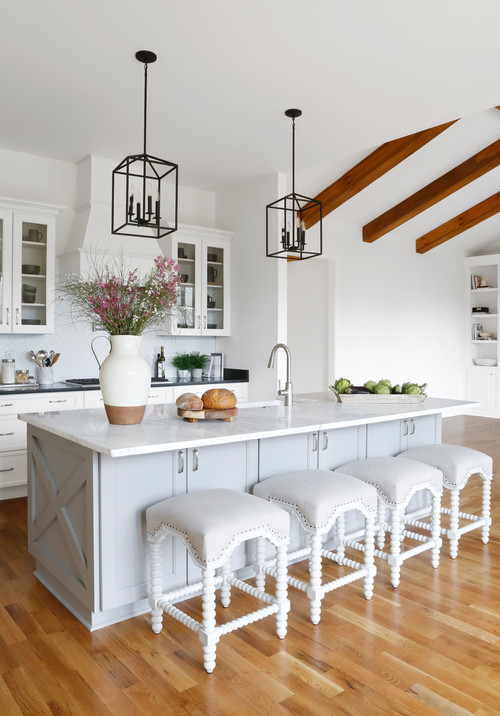
What is modern farmhouse style?
Modern farmhouse style is a design trend that combines the best of both worlds – a cozy farmhouse feel with modern sensibilities.
Modern farmhouse is perfect for those who want to add a bit of rustic charm to their home without sacrificing modern conveniences.
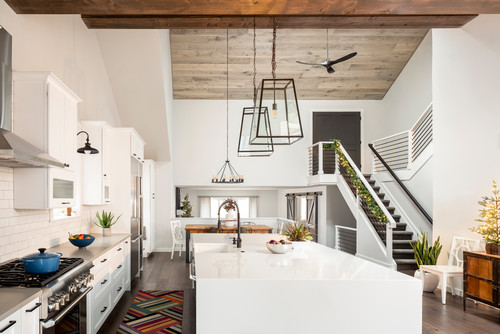
Transitional style vs. Modern farmhouse style: The differences
The most significant difference between transitional and modern farmhouse styles is probably that transitional design is more modern and sleek, while farmhouse is cozier and more rustic.
This comparison of transitional style and modern farmhouse style breaks it down even further:
Transitional Style
- Combines both traditional and contemporary design elements
- Features clean lines and neutral colors
- Will have a mix of textures and materials, such as glass, metal, and wood
- Accessorizes with geometric patterns, glass or crystal decor, and abstract art
- Often uses mid-century modern furniture or sleek designs
- Contains elements that suggest luxury, such as a grand chandelier or mirrored surfaces
- Has a minimalist yet sophisticated look
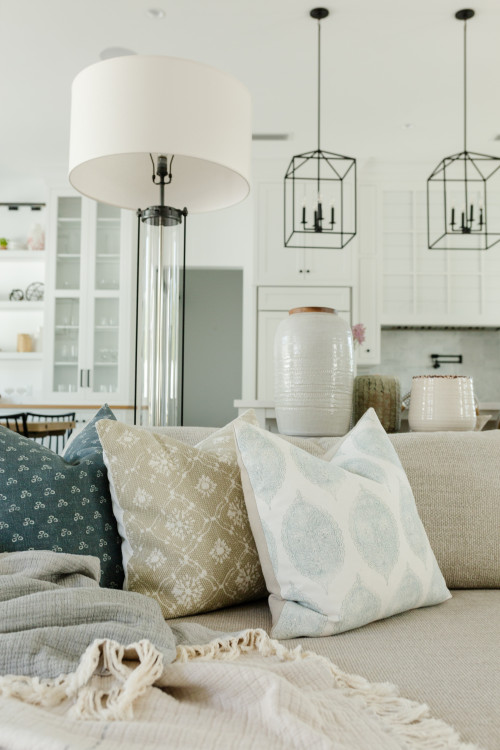
Modern Farmhouse Style
- Has a more rustic feel
- Features exposed wood, reclaimed wood, and shiplap
- Will often have a limited color palette of white, black, gray, and natural wood colors
- Accessorizes with vintage decor, such as mason jars and antique signs
- Often uses industrial lighting fixtures with rustic or vintage appeal
- Features natural textures such as linen, cotton, or burlap
- Has a cozy, warm, and inviting look
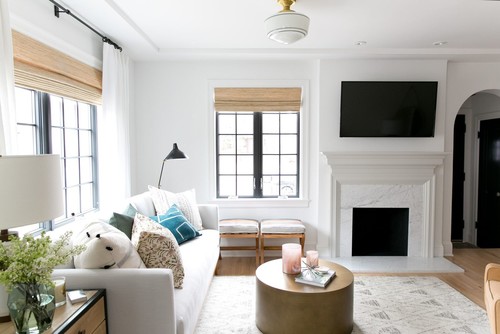
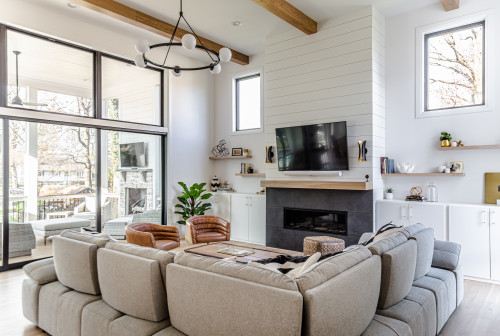
Is transitional style replacing modern farmhouse style?
There is no clear answer yet. It is still too early to tell if transitional style will completely replace farmhouse style, though we doubt it.
There is no doubt, though, that transitional design is becoming increasingly popular, especially among younger homeowners.
Transitional design is, in many ways, a more modern take on farmhouse style, so it will likely appeal to those looking for a fresh, updated look.
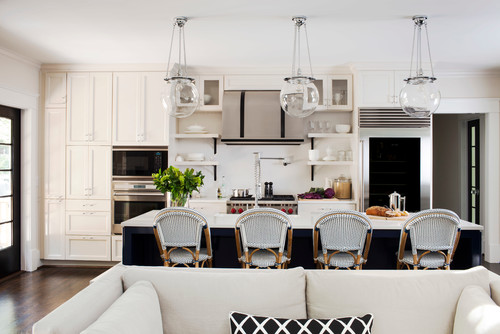
What are the basics of transitional design?
Transitional design embraces simplicity and clean lines. It combines traditional and contemporary elements to create a calming and inviting space.
The key features of transitional design include the following.
Clean lines
Transitional spaces are free of clutter and unnecessary decorations. This helps to create a feeling of peace and tranquility. It is important to note that transitional rooms can still be warm and inviting – they just tend to be more minimalistic.
Neutral colors
Transitional spaces typically use a neutral color palette. This helps to create a calm and serene environment. However, pops of color can still add interest and personality to a transitional space.
Natural materials
Transitional spaces often incorporate natural materials, such as wood and stone. This helps to create a warm and inviting space.
Simplicity
Transitional spaces are designed to be calm and relaxing. This means that they typically avoid busy patterns and over-the-top designs. Instead, transitional spaces focus on simplicity and functionality.
Functionality
Transitional spaces are designed to be both beautiful and functional. This means that they typically incorporate ample storage and comfortable furniture. Functional elements are often hidden away, such as in built-in cabinets or behind closed doors.
Simple shapes
Transitional spaces often use simple, geometric shapes. This helps to create a sense of serenity. Transitional spaces typically avoid overly complicated designs. Instead, the focus is on creating rooms with functional, understated elegance.
Warm woods
Transitional spaces often incorporate warm wood tones. This helps to create a cozy and inviting space. Wood furniture and floors are used in transitional spaces to add warmth and comfort.
Subtle textures
Transitional spaces typically use subtle textures to add interest. This can be anything from a textured rug to a woven throw blanket. Textures help to add visual interest and personality to a space that relies on neutral colors.
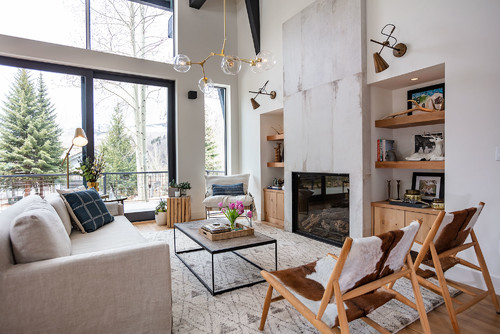
Pros and cons of these individual decorating styles
Both transitional and farmhouse styles have their unique pros and cons.
Pros of Transitional Style
- Allows you to easily incorporate modern elements
- Provides a modern update without major changes
- Creates a contemporary and timeless look that will never go out of style
- Great for a modern take on farmhouse style
- Functional design with clean lines and simple shapes
Cons of Transitional Style:
- May not be as cozy or warm as farmhouse style
- Can be more expensive to achieve as it often requires more modern and expensive materials
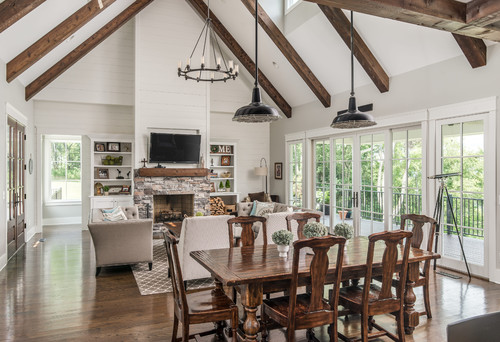
Pros of Farmhouse Style
- Warm and inviting with natural textures and lived-in charm
- A relaxed country look that can be timeless and classic
- Incorporates intricate details and antique/reclaimed materials for a unique style
Cons of Farmhouse Style
- Can be challenging to achieve a modern look with this style
- May require more frequent updates as trends change
- May be too rustic for some people’s tastes
Ultimately, the choice between transitional and farmhouse design styles will come down to personal preference and the unique needs of your space. Consider what design elements are essential to you and the atmosphere you want to create in your home.
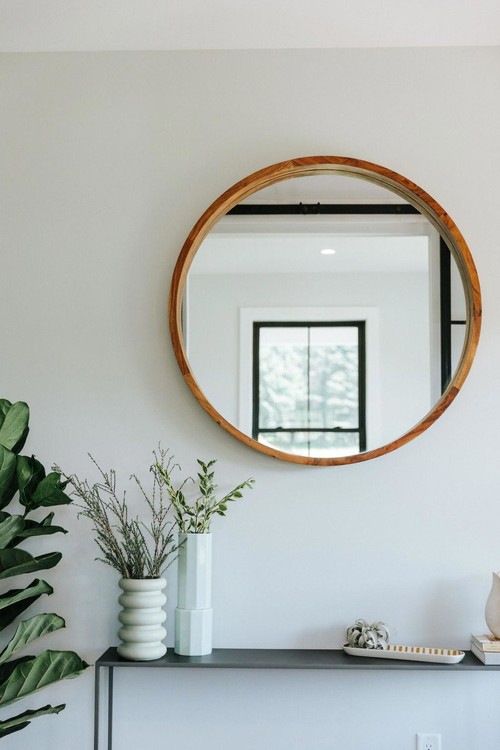
Designing Specific Spaces
Today’s blog explores transitional farmhouse design styles and how to incorporate them into specific spaces in your home. When designing, define your space and balance the elements. With these tips, you can create a fresh and inviting transitional farmhouse space that you, your family, and your friends will love.
Dining Room
Let’s start with the dining room, where you can create a fabulous combination of classic and modern farmhouse elements by using a neutral color palette and incorporating wood accents into the cabinetry, table, and accessories.
Family Room
In the family room, add warmth and texture to the space by balancing form and function with furniture choices such as a neutral-toned sofa, patterned pillows, and gorgeous lighting.
Master Bedroom
Finally, to create a timeless look in your master bedroom, consider a blend of transitional decor and traditional farmhouse elements. Use neutral colors, textures, and furnishings to achieve a cohesive look.
Comparing Modern Farmhouse & Transitional Farmhouse Interior Design Styles
You might be torn between transitional farmhouse and modern farmhouse styles. Both are rooted in traditional farmhouse design, but they do have distinguishing features that set them apart. Here’s a comparison of their defining characteristics:

Transitional Farmhouse
- Blends traditional farmhouse elements with contemporary or modern features
- Features a neutral color palette with a mix of textures and materials
- Incorporates clean lines and sleek finishes
- Accessorizes with geometric patterns, glass or crystal decor, and abstract art
- Combines classic and modern farmhouse elements
- Achieves a warm yet sophisticated look
- Creates an inviting space with a minimalist approach
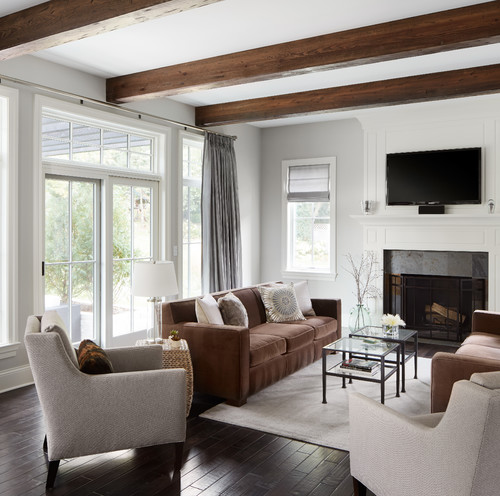
Modern Farmhouse
- Has a more rustic and traditional feel
- Features natural wood accents and white or black painted finishes
- Uses a limited color palette with natural textures like linen or cotton
- Often includes shaker-style cabinetry and a large kitchen island
- Vintage accessories and industrial lighting fixtures
- Incorporates cozy, warm, and inviting spaces with comfortable furnishings
- Defines spaces with simple lines, and a mix of traditional or modern elements
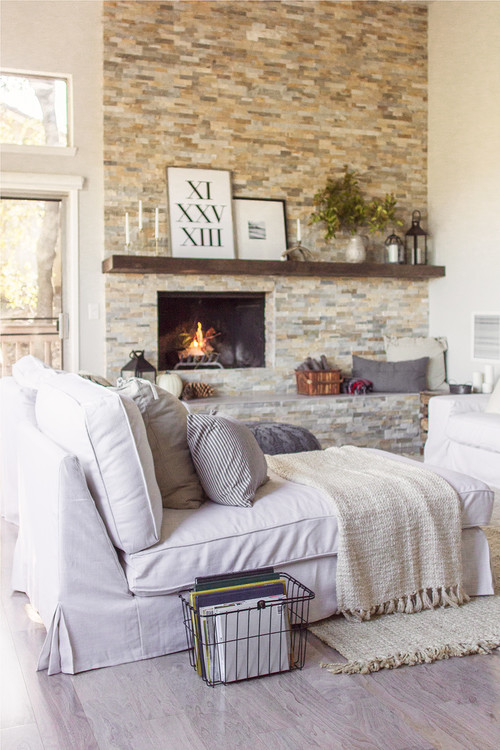
While both styles have a rustic charm and comfortable warmth, modern farmhouse style celebrates the traditional farmhouse aesthetic more than transitional farmhouse does.
Transitional farmhouse is a blend of traditional elements with modern sophistication.
In comparison, modern farmhouse style leans more towards minimalism, with traditional farmhouse elements at the forefront, creating a gorgeous combination in the overall look.

If you are in love with Studio McGee, you are already a transitional style fan!
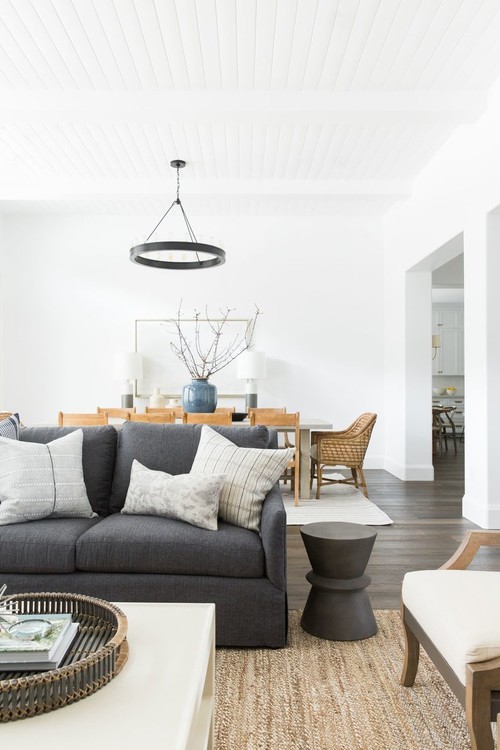
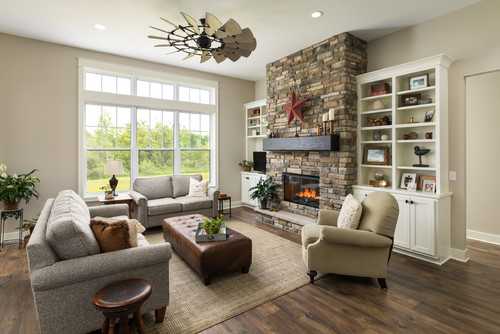
Elements and Accessories for Transitional Farmhouse Design
Design elements and accessories are the finishing touches that can make a house feel like a home. Here are some ways you can use them to create a stunning Transitional Farmhouse look:
Cabinetry and Storage
- Use shaker-style cabinetry with a neutral finish
- Incorporate open-shelving or glass display cabinets to showcase accessories
- Use vintage-inspired hardware to blend tradition with modern style
- Find unique storage solution options like wicker baskets, storage seating benches, and coat racks that compliment your overall style.

Lighting and Fixtures
- Use lighting to add warmth and texture while also providing function
- Consider pendant lights with clean lines that balance form and function
- Use fixtures of varying finishes to add depth and interest
- Invest in a combination of table lamps as well as overhead light fixtures like chandeliers

Textures and Furnishings
- Use natural elements like jute, sisal, or woven fabrics to complement transitional farmhouse style
- Add in throw pillows, blankets, and other accents with a mix of patterns
- Incorporate different furniture styles and finishes to create a cohesive look
- Invest in a blend of modern and vintage furniture and accents
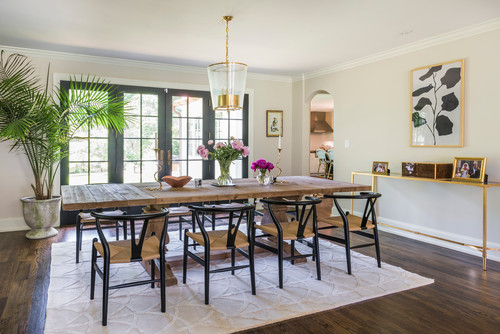
These tips will allow you to create a gorgeously designed transitional farmhouse space that exudes warmth and grace with a defined sense of balance.
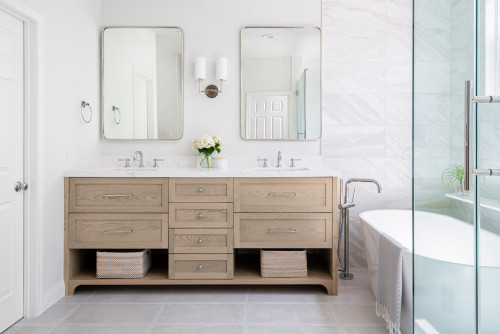
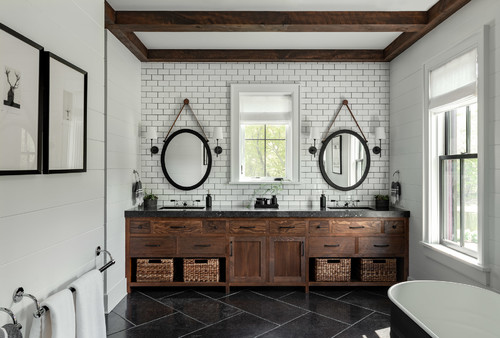
So, which style should you pick?
If you have been invested in modern farmhouse but feel like you are ready for a change, transitional style is a great bridge. You can incorporate many elements you love about farmhouse style into a transitional space.
If you are starting from scratch, transitional style may be a better choice since it is more versatile and can be adapted to many different homes.

If you’re just not sure which style to choose, Transitional Style, Modern Farmhouse Style, or Transitional Farmhouse Style, consider these points:
1. Consider your preferences: Consider the style that makes you feel comfortable and happy. This should help you determine what aspects of each style speak to you the most.
2. Assess your space: Take a closer look at the space you want to decorate. Pay attention to the lighting, the size, the amount of furniture you own, and what colors are present. This will give you a better idea of which style will blend into the room if you don’t want to do a complete overhaul.
3. Think about texture: If you’re a fan of wood surfaces, neutral colors, and warm tones, then you might prefer going for a farmhouse style. On the other hand, if you like defined lines, clean shapes, and modern textures, transitional style might be your best bet.
4. Play around with colors: Since all three styles rely on neutral colors, you can use tone and balance to incorporate pops of your favorite hues. Take note of the room you’re decorating and experiment with different color schemes to see which will highlight the room’s strengths.
5. Explore different patterns: Patterns play a significant role in all three styles, so you can have fun with different combinations of patterns to create a fresh, vibrant look.
6. Accessorize with pillows and textures: Farmhouse style focuses on warmth and coziness, while transitional style leans towards balance and grace. Adjust your pillow and texture choices depending on your preferred aspect until you create the perfect combination.
7. Check out different images for inspiration: Visit blogs, scroll through websites for shopping options, or browse through images on social media sites like Pinterest and Instagram. We know you’ll find some excellent ideas to incorporate into your home.
8. Make your choice: Ultimately, your style should feel genuine and authentic to your personality, taste, and space. Trust your instincts and have fun creating your dream space!
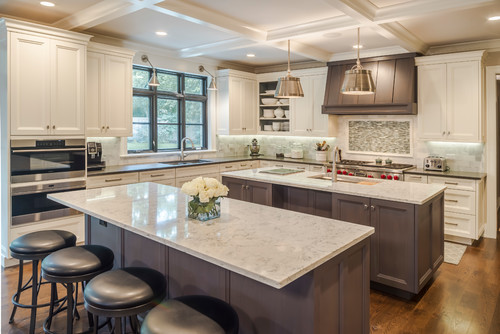
No matter which style you choose, make sure that it reflects your taste and style. After all, your home should be a reflection of you and your family, and ultimately you are the one who will be living in it!
What do you think of transitional style? Do you prefer it to farmhouse style? Are you going to try transitional farmhouse design? Let us know in the comments!
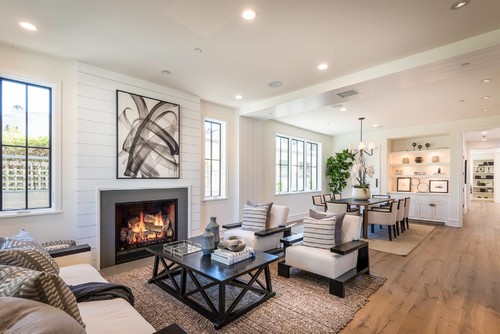
FAQs
1. What is the difference between transitional and farmhouse kitchens?
Transitional style kitchens blend traditional elements with modern sophistication, while farmhouse style leans more towards minimalism and traditional farmhouse elements. Additionally, transitional kitchens usually have a neutral color palette, while farmhouse kitchens may incorporate more rustic colors and textures.
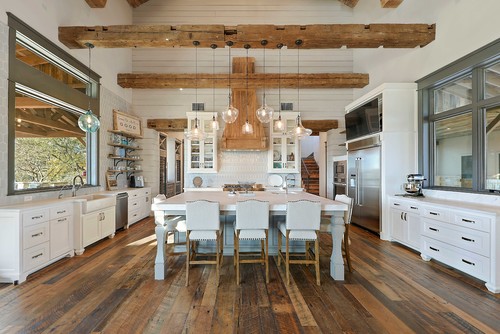

2. Which living room style should I choose?
Transitional style kitchens blend traditional elements with modern sophistication, while farmhouse style leans more towards minimalism and traditional farmhouse elements. Additionally, transitional kitchens usually have a neutral color palette, while farmhouse kitchens may incorporate more rustic colors and textures.
The living room style you choose will depend on your preferences, the size of your space, and the colors already present in the room. Consider which style speaks to you the most, assess your space, and explore different color schemes until you find what works best for your home.

3. My house decor is outdated. What are some interior design tips for updating it with transitional farmhouse style?
If you want to update your house decor with transitional farmhouse style, here are some tips to get you started:
1. Start with a neutral color palette – A neutral color palette is a key element of both transitional and farmhouse styles. Choose warm whites, grays, and earthy taupe shades for your walls and floors. Consider using a natural wood finish for your furniture pieces.
2. Combine old and new elements – Mix traditional and modern styles to achieve a transitional farmhouse look. For example, pair a vintage wooden table with more modern metal chairs, or mix industrial light fixtures with weathered wood accents. Emphasize simple and clean design with a touch of rustic texture.
3. Use natural materials – Whether it’s wood, stone, or linen, natural materials are essential to the farmhouse aesthetic. Rattan, jute, and sisal floor coverings may also work.
4. Incorporate texture – Texture adds depth and interest to a space. Textural elements like baskets, woven rugs, throw blankets, or cushions create a cozy and welcoming atmosphere.
5. Add greenery – Nothing says farmhouse like fresh plants and cut flowers. Consider adding some greenery or fresh flowers to your decor. Big leafy plants in rattan baskets or vases of wildflowers add a casual, organic vibe to your space.
6. Accessorize with vintage finds – Incorporate vintage pieces like antique mirrors, old signs, or well-worn books for an authentic farmhouse feel. Peruse local flea markets or thrift stores for unique finds that fit the transitional farmhouse style.
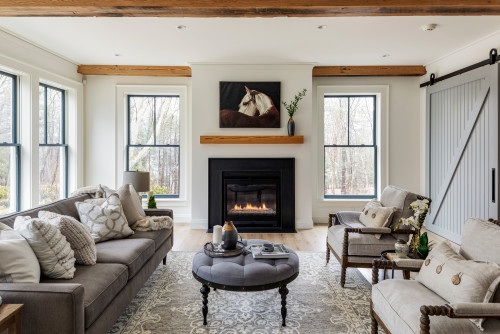
These tips will allow you to update your house decor and create a cozy, welcoming, and updated transitional farmhouse-style space.
4. What can I purchase to make my entryway a transitional farmhouse space?
To make your entryway a wonderful transitional farmhouse space, look for furniture and accessories that have a timeless classic feel with modern touches.
Your front door can be a great focal point, and glass or wood panels can help create an inviting entrance. You can also bring classic furniture pieces like a sofa and a table to create an inviting atmosphere and fun accessories like pillows, lighting fixtures, and, depending on your entry, even a piece of antique patio furniture.
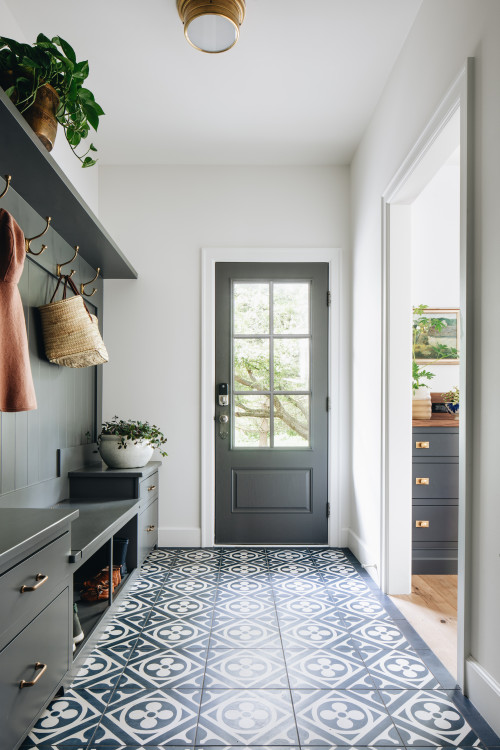
Finally, don’t forget to explore different textures and patterns to blend timeless style with a modern flair. Ideas like these can help you create your own unique transitional farmhouse space!
For instance, you could look for a classic wooden bench with clean and straight lines and pair it with a modern striped pillow to balance traditional and contemporary styles.
Or, add a vintage rug in neutral tones to bring a cozy and rustic element to your entryway. Keep the color palette neutral with shades of white, cream, beige, and black, and add pops of color with fresh greenery or a vase of bright flowers.
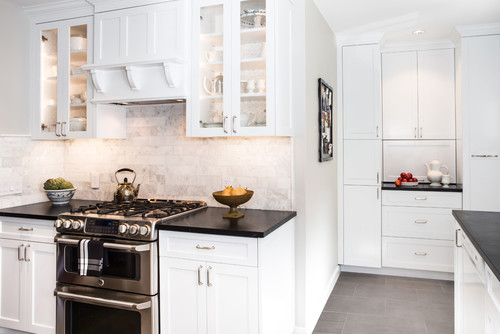
6 comments
Comments are closed.